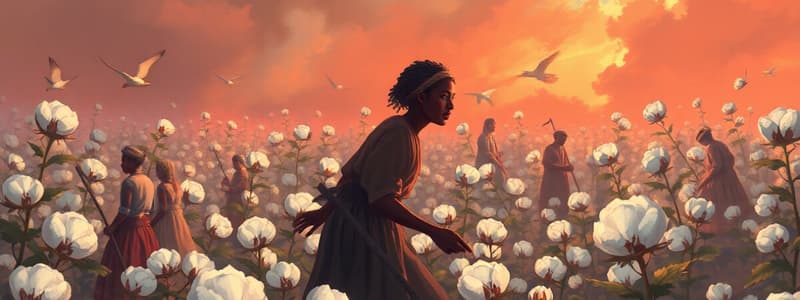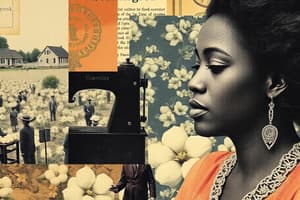Podcast
Questions and Answers
What percentage of southern whites owned no slaves?
What percentage of southern whites owned no slaves?
- 50%
- 25%
- 40%
- 75% (correct)
What characterized a planter in the southern society?
What characterized a planter in the southern society?
- Was primarily a laborer on the farm
- Owned fewer than ten slaves
- Managed plantations of about a thousand acres (correct)
- Participated actively in day-to-day plantation management
What was a common aspiration for small slaveholding farmers?
What was a common aspiration for small slaveholding farmers?
- To labor without slaves
- To sell their slaves for profit
- To become planters themselves (correct)
- To own their own machinery
What social standard was expected from southern women that was not expected from men?
What social standard was expected from southern women that was not expected from men?
How did the role of a southern planter's wife differ from that of men?
How did the role of a southern planter's wife differ from that of men?
Which crop was commonly tended to by yeoman farmers for their own consumption?
Which crop was commonly tended to by yeoman farmers for their own consumption?
What contributed to the diversification of agriculture in this part of the South?
What contributed to the diversification of agriculture in this part of the South?
What social consequence did white men face for fathering mulatto children on plantations?
What social consequence did white men face for fathering mulatto children on plantations?
Which cash crop had the highest proportion of production in the South during this period?
Which cash crop had the highest proportion of production in the South during this period?
What was the primary focus of a planter's economic decisions?
What was the primary focus of a planter's economic decisions?
Why did planters in the South find themselves with more slaves than they needed?
Why did planters in the South find themselves with more slaves than they needed?
Who was considered the largest single group of southern whites?
Who was considered the largest single group of southern whites?
What was a key difference between the planter class and typical farmers?
What was a key difference between the planter class and typical farmers?
What was one of the primary reasons for the profitability of slavery in the South?
What was one of the primary reasons for the profitability of slavery in the South?
What type of slave labor represented the largest percentage of the enslaved population?
What type of slave labor represented the largest percentage of the enslaved population?
What was a key characteristic of the economy and society of the South during this period?
What was a key characteristic of the economy and society of the South during this period?
Which group of slaves was likely to fetch the highest market price?
Which group of slaves was likely to fetch the highest market price?
Which city became a major center for the internal slave trade?
Which city became a major center for the internal slave trade?
What economic strategy did some slave owners employ to increase their income?
What economic strategy did some slave owners employ to increase their income?
How did prices for slaves change as cotton production expanded?
How did prices for slaves change as cotton production expanded?
What factor primarily contributed to the growth of the slave population in the United States from 1790 to the eve of the Civil War?
What factor primarily contributed to the growth of the slave population in the United States from 1790 to the eve of the Civil War?
Which of the following territories was explicitly barred from slavery by the Northwest Ordinance of 1787?
Which of the following territories was explicitly barred from slavery by the Northwest Ordinance of 1787?
What major invention facilitated the increased economic viability of cotton production in the South?
What major invention facilitated the increased economic viability of cotton production in the South?
By 1860, which of the following regions had the highest concentration of slaves in the United States?
By 1860, which of the following regions had the highest concentration of slaves in the United States?
What was one primary reason that the foreign slave trade's official end in 1808 did not significantly impact the slave population?
What was one primary reason that the foreign slave trade's official end in 1808 did not significantly impact the slave population?
Which states were considered part of the Upper South, serving as the primary source of slaves for the Cotton Kingdom?
Which states were considered part of the Upper South, serving as the primary source of slaves for the Cotton Kingdom?
What was a significant outcome of the depletion of soil in tobacco-growing regions of the South?
What was a significant outcome of the depletion of soil in tobacco-growing regions of the South?
Which of the following aspects characterized slavery in the North compared to the South during the American Revolution?
Which of the following aspects characterized slavery in the North compared to the South during the American Revolution?
The cotton gin's introduction coincided with which significant event related to Native Americans?
The cotton gin's introduction coincided with which significant event related to Native Americans?
What was the primary economic crop that drove the expansion of slavery into the Deep South by 1860?
What was the primary economic crop that drove the expansion of slavery into the Deep South by 1860?
What was a significant reason why yeoman families in the South supported slavery despite not owning slaves themselves?
What was a significant reason why yeoman families in the South supported slavery despite not owning slaves themselves?
Which group occupied the lowest social rung among whites in the Southern hierarchy?
Which group occupied the lowest social rung among whites in the Southern hierarchy?
What was one of the primary health issues affecting poor whites in the South?
What was one of the primary health issues affecting poor whites in the South?
What was a common occupation for free blacks in the Southern states?
What was a common occupation for free blacks in the Southern states?
In which states were a significant number of free persons of color concentrated before the Civil War?
In which states were a significant number of free persons of color concentrated before the Civil War?
What was one reason mulattos may have looked down upon those with darker skin?
What was one reason mulattos may have looked down upon those with darker skin?
Which of the following best describes the general economic condition of yeoman families in the South?
Which of the following best describes the general economic condition of yeoman families in the South?
What characterized the diet of poor whites in the South?
What characterized the diet of poor whites in the South?
What role did religion play in the lives of free blacks in the South?
What role did religion play in the lives of free blacks in the South?
How did the living conditions of slaves compare to those of poor whites?
How did the living conditions of slaves compare to those of poor whites?
Flashcards are hidden until you start studying
Study Notes
Slavery in the US
- Slavery was a widespread practice in the US before the revolution and existed in all colonies.
- Northern states began abolishing or gradually emancipating slaves even before the Constitution was ratified.
- The Northwest Ordinance of 1787 prohibited slavery in new territories, effectively confining slavery to the South.
- The slave population in the US increased significantly between the first federal census (1790) and the eve of the Civil War.
- Natural population growth accounted for the majority of the slave population increase, despite the end of the official foreign slave trade in 1808.
- Slavery was concentrated in the tobacco-growing areas of the South before 1820.
- By 1860, slavery had expanded significantly into the Deep South, driven by the growth of cotton production.
- Cotton production was essential for the Southern economy and relied heavily on slave labor.
Cotton Industry and the "Cotton Kingdom"
- The invention of the cotton gin significantly boosted cotton production and increased the demand for slave labor.
- The Cotton Kingdom, a region spanning the Deep South, became a major economic force.
- The Upper South, including border states, served as the main source of slaves for the Cotton Kingdom.
- The Upper South was diversifying its agricultural practices beyond cotton, leading to a surplus of slaves.
- Alexandria, Virginia, became a hub for the internal slave trade.
Slavery as an Economic Institution
- Domestic servants, skilled craftsmen, and mill workers made up a small percentage of the slave population.
- The majority of slaves worked as field hands, contributing to the agricultural economy of the South.
- Slavery was considered profitable for planters.
- Slaves were regarded as valuable assets, with their prices rising alongside the demand for their labor.
- Slave ownership was a significant investment for planters, yielding additional income through buying and selling slaves.
Social Hierarchy in the South
- While the image of a South where all whites owned slaves is a myth, three-quarters of southern whites were non-slaveholders.
- The planter class, owning 20 or more slaves and vast plantations, held considerable power and influence.
- The planter's wife managed the domestic slaves, maintained the household, and bore the burden of interracial relationships and their consequences.
- Yeoman farmers, representing the majority of southern whites, owned small farms and relied on their own labor, supporting slavery based on racial beliefs and economic interests.
- Poor whites, often struggling to survive on marginal lands, were at the bottom of the social ladder.
Free Blacks in the South
- More than a quarter million free blacks resided in the South, particularly in Maryland, North Carolina, Virginia, Charleston, and New Orleans.
- Free blacks were subject to discrimination and limited economic opportunities.
- Religion played a significant role in the lives of free blacks, with Baptist and AME churches holding prominent positions.
- Mulattos, often children of slave women and white men, constituted a significant percentage of free blacks and often held a higher social status than those with darker skin.
Studying That Suits You
Use AI to generate personalized quizzes and flashcards to suit your learning preferences.




